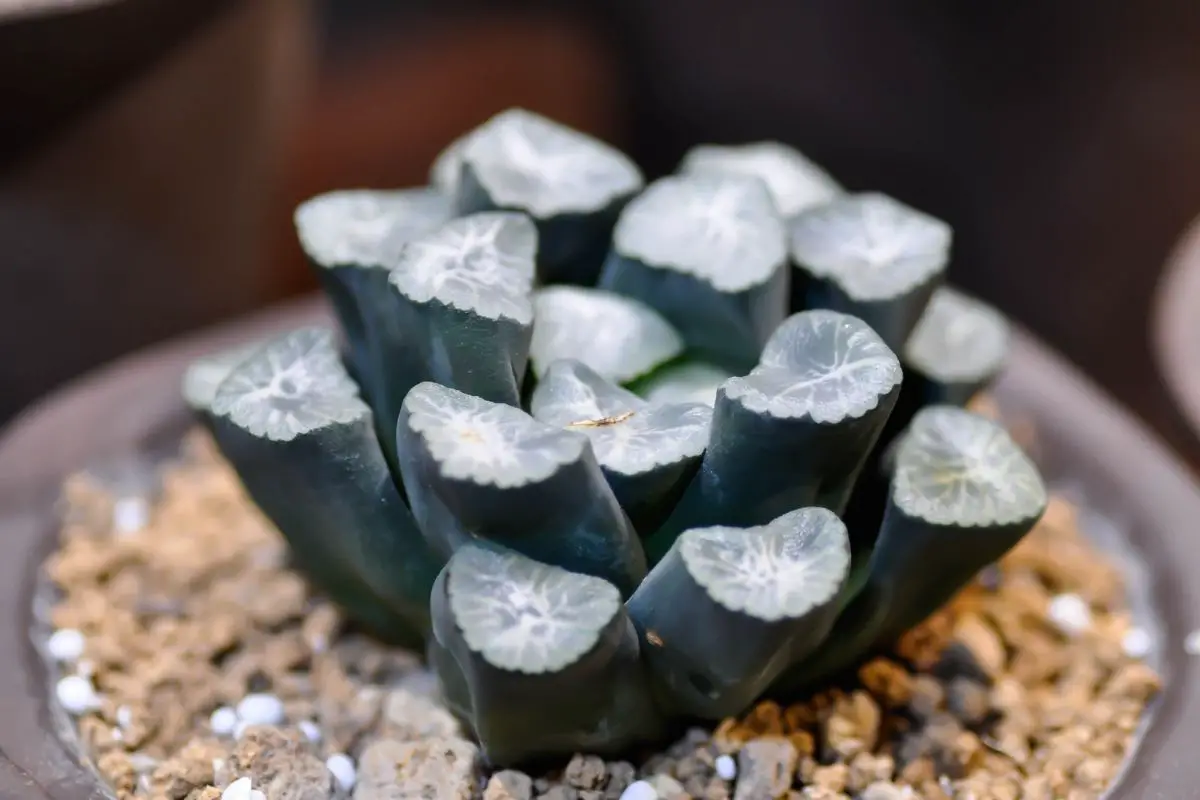This is undoubtedly one of those succulents that will make you stop in your tracks. Haworthia truncata is distinguished by foliage that can sometimes look like rocks. One will understandably feel compelled to touch the leaves, which fan out evenly from the center of the plant.
This species doesn’t form typical rosettes as its leaves occur in rows instead of spirals. It may arise in dense clumps, but those cultivated in greenhouses may occur singly for quite some time due to their slow growth rate. This perennial species grows most actively in late spring and can become dormant under intense heat conditions.
Most of the plant is dark green in color, apart from the flat surface of the leaves. These tend to be wholly translucent, allowing light to permeate further into the leaf tissues. This comes in handy during droughts, when contractile root systems pull the entire plant into the ground. Only the leaf surfaces, which resemble windows, remain exposed on the soil surface.
History
H. truncata is endemic to Little Karoo, a semi-desert region in the Western Cape Province of South Africa. It can be extremely hard to spot this plant in the wild for two reasons. It grows to a maximum height of just 0.8 inches (2 cm) and its foliage is often masked by the substrate. Even those that are fully exposed may look uncannily like rocks.
The species epithet, ‘truncata’, refers to the appearance of the plant’s leaf surfaces. It is based on the Latin word truncatus, which means ‘mutilated’. The flat and seemingly abrupt leaf ends make the plant look as though it was sliced through cleanly, revealing a cross-section. Nowadays, H. truncata is more fondly referred to as horse’s teeth!
Plant Facts
| Scientific name | Haworthia truncata |
| Common names | Horse’s Teeth |
| Genus | Haworthia |
| Family | Asphodelaceae |
| Height | 0.8 inches |
| Width | 4 inches |
| USDA Plant Hardiness Zone | 10a – 11b |
| Origin | Western Cape Province, South Africa |
| Flower colors | White |
| Blooming season | Late spring |
| Plant/Flower special features | Rock-like foliage, translucent leaf tips |
How to Plant Haworthia truncata
As this species is remarkably small, it is normally cultivated in tiny pots that are just a few inches tall. Unlike those found in the wild, clumps in cultivation can have the rows of leaves fully exposed for proper viewing. If your substrate is optimal, the foliage can also be situated deeper into the soil to highlight the appearance of the leaf windows.
Don’t be intimidated by this plant’s strange appearance! H. truncata is actually quite easy to grow. Its colonies can be enlarged via offsets, root divisions, and even with the use of leaf cuttings.
How to Propagate Haworthia truncata
H. truncata can take years to fully mature and produce offsets, so you should consider propagating the plant through division or via leaf propagation. When dividing the plant or taking leaf cuttings, always make sure to use sterilized tools.
Make sure any exposed tissues are fully calloused before exposing them to soil. Healthy divisions or cuttings should readily produce new root tissues. Once their root systems are large enough to be handled, plant them in a well-draining substrate.
Care and Maintenance
Follow our haworthia care instructions below to grow healthy plants:
Soil
A commercial mix made for succulents and cacti can be used. Porousness can be increased by adding sand, stones, and pumice to the mix.
Water
H. truncata is drought-tolerant and will require moisture only when the soil has dried out completely. Water the soil directly and thoroughly (soak-and-dry method).
Fertilizer
You may provide the plant with a dilute fertilizer during its growth period.
Sunlight
H. truncata can slowly become acclimated to withstand full sun exposure, but filtered sunlight is best. Intense exposure can cause the leaves to wither or become more yellow to red in color.
Temperature and Humidity
A temperature range of 75-90F is best for H. truncata. It can withstand cool winters but should not be exposed to temperatures below 5F for long periods of time.
Pruning
Only the flower stalks will require pruning once they are spent.
Repotting and Transplanting
Repot your H. truncata clumps every 2-3 years. This should be done during spring or autumn.
Pests and Diseases
As long as environmental conditions are optimized for H. truncata, it should remain pest and disease-free.
Uses of Haworthia truncata
Due to its miniature size, this species is cultivated mainly to meet collector’s demands. It is also used as a desk plant.
Common Varieties
Popular Haworthia cultivars tend to have minor variations in leaf form and orientation, with some being highly prized for their variegation. Selective breeding and hybridization has generated many colorful cultivars.
- H. truncata var. maughanii
- H. truncata var. truncata (synonymous with f. minor and f. crassa)
- H. truncata ‘Lime Green’
- H. truncata ‘Variegata’
- H. truncata ‘Green Rose’
Conclusion
Though commonly cultivated, this succulent will set your collection apart! It has several adaptations that make it unique, even in the world of succulents.
~ image source: depositphotos/jobrestful

